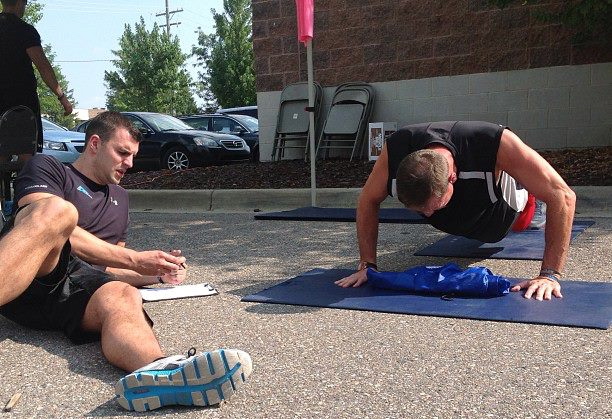Heat waves account for more deaths every year in the United States than any other form of natural disaster. While not all of these instances are exercise related, it goes to show how serious one must be about working out safely in extreme heat. Through knowledge of the signs and symptoms, and taking the proper precautions, you should be able to safely enjoy outdoor exercise this summer.
Explanation & Identification of Heat Illnesses
Heat stroke is the most severe form of heat illness and occurs when our temperature regulation system is completely overwhelmed, leading to skyrocketing core temperatures. When body temperature reaches 104o F or greater, loss of consciousness, seizure, and slow heart and breathing rate are common occurrences. Symptoms preceding heat stroke include lack of sweat, confusion, dilated pupils, and a fast unsteady pulse. Thirst IS NOT a valid indicator!
Heat exhaustion is a less dangerous form of heat illness related to severe water and sodium loss through sweating. Symptoms include extreme thirst, headaches, general discomfort, severe muscle pain and cramps, dizziness, and nausea. Heat exhaustion may precede heat stroke, so being aware of the symptoms is vital to exercising safely in the heat.
Risk Factors
If any of the following conditions apply to you, take extreme care, and consult a health professional before exercising in extreme heat.
- Use of stimulant drugs, or medications such as beta-blockers, many anti-depressants, and diuretics.
- Children and those over the age of 65 are more prone to heat illness.
- Sunburn or psoriasis which interferes with sweating.
- Alcoholism or recent binge drinking
- Cardiopulmonary disease
How Can I Be Prepared?
The purpose of this blog is not to scare you out of exercising outdoors. Exercising in the heat can still be a safe activity so long as it is done properly. Below are some tips to exercise safely this summer:
Give yourself time to acclimate to the heat.
Light activity in the heat for 5-7 days before intense exercise has been shown to improve the ability to regulate body temperature.
Stay hydrated.
Try to drink 20 oz of fluid two hours prior to exercise, another 8 oz right before, and then two large sips every 10 to 15 minutes while exercising. Eating a healthy diet and getting fluids in throughout the week is also important.
Do not exercise in the middle of the day.
Try to get out early in the morning or in the later evening hours to avoid the worst of the temperatures.
Have a plan.
An extremely hot day is not the time to go for a spontaneous run or ride; know your route, and include shaded stretches. Also, be sure to let someone know that you are going out to exercise and will let them know when you’re done.
Listen to your body and be smart.
The humid 95o F day is not the time to push your luck if you are feeling abnormally tired, or if your diet has been crummy recently. Nor is it the time to try a brand new activity. Even if you are on a strict mileage plan leading up to an event, it is not worth it to push the pace or mileage in abnormally sweltering heat. Use common sense, and be safe.
Take Home Message
Exercising outdoors can be a great way to jumpstart your workout routine and promote adherence; however you must be smart when it is very hot out. Exercise safely this summer by being aware of the signs and symptoms of heat illnesses, and through utilizing the tips above.
About the Author:
-

Michael Stack is the founder & CEO of Applied Fitness Solutions and Frontline Fitness Pros. He is a faculty lecturer for the University of Michigan’s School of Kinesiology. He is also the creator and the host of the Wellness Paradox Podcast, produced in conjunction with University of Michigan.
Michael is an exercise physiologist by training and a health entrepreneur, health educator, and fitness industry advocate by trade. He is dedicated to enhancing the standard of practice of, and advocating for, fitness and wellness professionals to ensure they become an essential constituent in the healthcare delivery system.
With a career spanning over three decades in fitness, health, and wellness Michael has a deep knowledge of exercise physiology, health/wellness coaching, lifestyle interventions to mitigate chronic disease and leadership. He is credentialed through the American College of Sports Medicine (ACSM) as an Exercise Physiologist (ACSM-EP), Exercise is Medicine practitioner (ASCM-EIM), and a Physical Activity in Public Health Specialist (ACSM-PAPHS). Michael is a National Strength & Conditioning Association (NSCA) Certified Strength & Conditioning Specialist (CSCS), and a CDC Diabetes Prevention Program (DPP) Lifestyle Coach.
Michael received his undergraduate degree from the University of Michigan’s School of Kinesiology in 2004 and is currently a Master’s of Public Health (MPH) candidate at University of Michigan, with a specific concentration in health behavior and health education.
Michael is a board of directors’ member for the Physical Activity Alliance and Michigan Fitness Clubs Association. He sits on the University of Michigan’s School of Kinesiology Alumni Board of Governors. Michael is an expert curriculum reviewer for the American College of Lifestyle Medicine. Finally, he is a member of the executive leadership team for American Heart Association’s Heart Walk.
Michael lectures nationally for several health/fitness certification and continuing educations, including; IHRSA, the Medical Fitness Association, the National Strength & Conditioning Association, and SCW Fitness.

